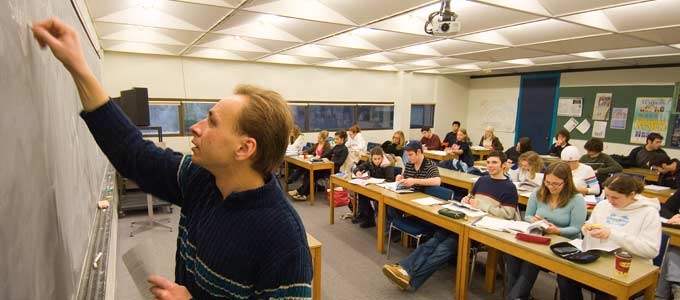Mathematics public lecture series

Nipissing’s Department of Computer Science and Mathematics is pleased to announce a series of lectures aimed at area high school students and the general public.Each lecture will work to explain popular topics in modern mathematics, physics and/or computer science.
There are currently five lectures planned over the academic year with the first one taking place on November 18, featuring Dr. Alex Karassev discussing Aperiodic Tilings
Abstract: A tiling is a cover of the plane by various shapes without gaps and overlaps. Floor tiles and mosaics, wallpaper patterns, brick and stone sidings are familiar examples of tilings. These tilings are usually periodic, i.e. the whole tiling can be shifted to obtain a perfect copy of itself. In the physical world, periodic tilings (of the space) can be used to model crystals . Surprisingly, there are tilings that lack such “shifting” property. Such tilings are called aperiodic. Although interesting by themselves, aperiodic tilings also found their real-world applications.
Properties of aperiodic tilings are related to properties of quasicrystals – a special types of arrangements of certain chemical compounds.
All lectures run from 1:15 – 2:30 p.m. in room A129 and are free of charge.
Future lectures include:
December 9 - Dr. Logan Hoehn
Title: Some facts and mysteries about prime numbers
Abstract: In the unending list of numbers 1,2,3,4,5,...., the prime numbers 2,3,5,7,11,.... pop up now and then in a mostly unpredictable pattern. In fact, there are several unsolved mysteries concerning the locations of prime numbers that have eluded mathematicians for many hundreds of years. I will give a sampling of some ideas for how to study prime numbers, and discuss some very old unsolved problems and recent progress on them.
February 17 - Dr. Ihor Stasyuk
Title: Infinite Series
Abstract: In many mathematical problems a solution can be expressed as the sum of a series, a summation that has infinitely many terms. We will discuss series through the history of mathematics, consider their general properties, interesting examples and unsolved questions.
April 21 - Dr. Vesko Valov
Title: Impossible Constructions
Abstract: We will talk about the three most famous geometric constructions, impossible to perform using compass and straightedge. The problems of squaring the circle, doubling the cube, and angle trisection have been known for over 2000 years, but impossibility of these constructions has been completely proved only in 19th century. Attempts to solve these problems led to significant discoveries in geometry, algebra, and number theory.
May 26 -Dr. Ali Hatef
Title: Quantum Dot Nanophotonics
Abstract: Quantum dots (QDs), known as artificial atoms, are nanoscale semiconductor materials with a unique size- tunable optical property. These unique size dependent qualities lead to a narrow photoluminescence spectrum in the range of visible to infrared light. QDs have attracted tremendous attention in the past few years for a variety of scientific and commercial applications such as biological sensors, quantum computing, photovoltaic and light emitting devices. In this talk we present a brief description of QDs and their associated optical properties, highlighting the concept the size dependent photo-physical properties. We also show how the coupling of QDs with the other nanostructures can dramatically alter the QDs photoluminescence for further development of QDs for each respective application.
